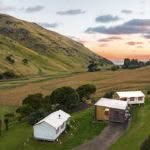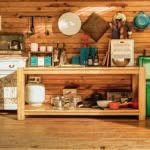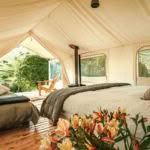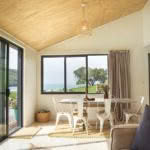A generations-old family farm on the Banks Peninsula is straight out of a storybook
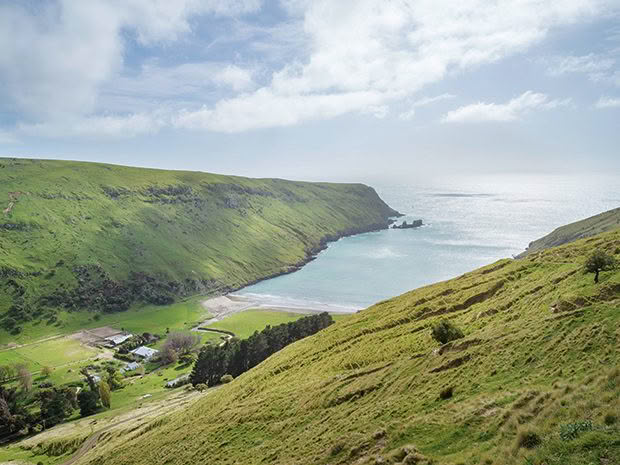
To reach Lavericks Bay, head towards Akaroa, swing up and over the hill to Le Bons Bay, and then down the steep road that ends at the Chapmans’ picturesque private beach. Harriet’s grandmother would once catch a boat from a now non-existent wharf to attend boarding school in Christchurch. “She was only four when she started — can you imagine? The youngest boarder they had ever accepted.”
Seven generations of one family have loved Lavericks Bay life, and now visitors can also enjoy the many charms of this secluded sheep farm.
Words: Fiona Fraser Photos: Rachael McKenna
The weather is a harsh mistress. Sunshine casting a comforting glow over pasture can quickly turn to drought. And a sprinkling of rain to signal that the drought has broken can give way to torrents of water, forcing the earth to crumble beneath its weight.
Harriet and Lloyd Chapman, who live in relative isolation in Lavericks Bay, Banks Peninsula, are marking one year since a flash flood pushed them and their historic property to the brink. The 1000-hectare sheep and beef farm has been in Harriet’s family for seven generations. Its beauty is undeniable — the view of a twinkling teal-blue ocean and a curve of golden sand on a private beach perfectly positioned for the sunrise.
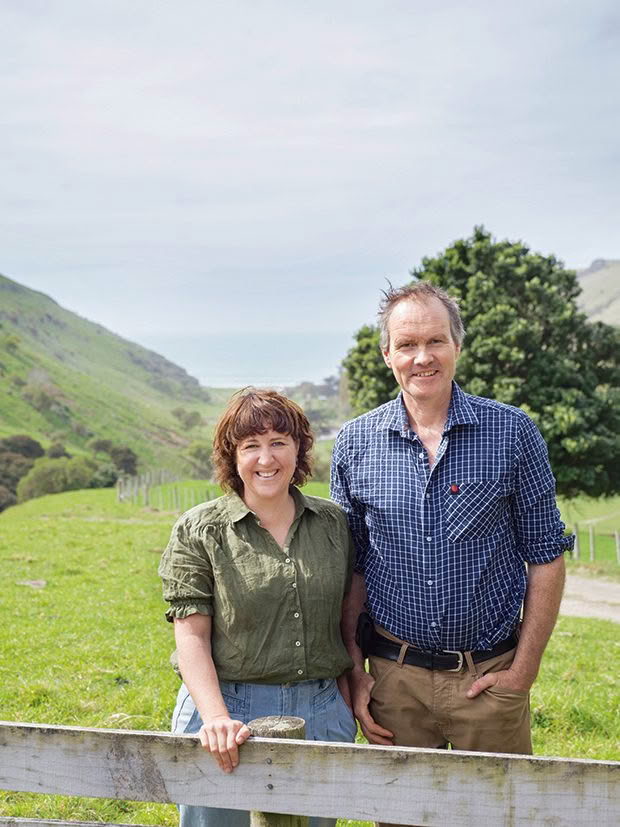
It’s sandwiched between enormous cliffs dotted with thousands of romney ewes, some balancing somewhat precariously upon steep rocks. There’s the archetypal Kiwi woolshed where Harriet celebrated her 21st and the family homestead, built in 1908 and currently occupied by Harriet’s uncle — Guy de Latour. Harriet, Lloyd, and their three children enjoy the more modern farmhouse further up the valley. Plus, there’s the Chapmans’ successful glamping operation. All were at risk of being lost on that wild and terrifying day in December 2021.
Harriet was 30 minutes away, watching their youngest daughter’s school prizegiving on the more reliable wifi at a friend’s house (Covid-19 having ruled out attending in person), and Lloyd was on a pocket of nearby land weaning lambs when the rain began to fall. “I drove home, and when I saw how heavy it was here at Lavericks, I rang Lloyd,” Harriet remembers. “We asked one of our farm workers to stay with the kids and started shifting rams. But the weather had well and truly turned — it just got worse, and worse, and worse. It was horrific.”
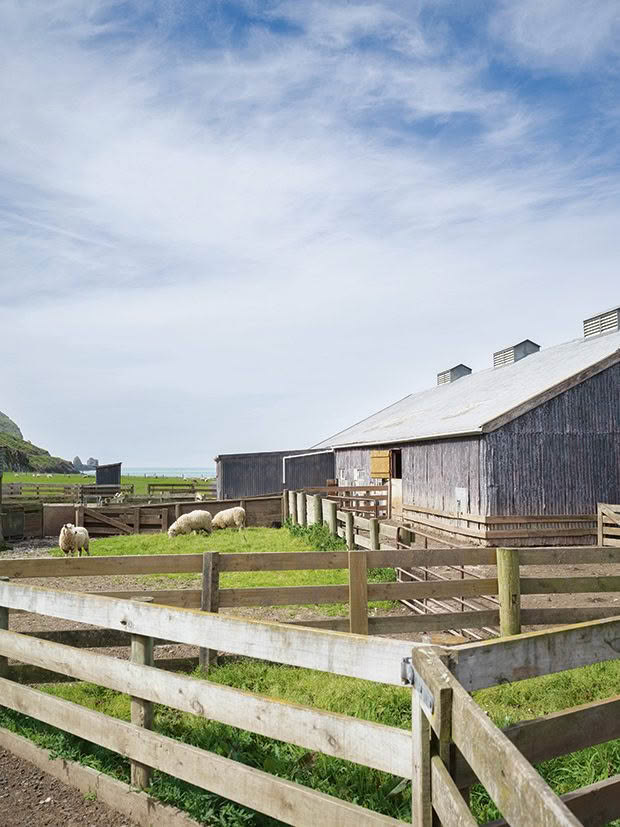
Stockyards captured much of the debris that tumbled down the hills during the “big rain”, causing the property to flood. Harriet recalls ordering a load of pea hay to be dropped off that day. “As it turned out, gardening was the last thing on my mind, but the delivery truck came in handy to move our wool bales and get them out for scouring asap,” says Harriet.
Several slips had destroyed the metal road linking the 1982-built farmhouse and the beachfront homestead, and the phone lines were down. They had no idea how Uncle Guy was faring and couldn’t get to him.
“Our stockyards sit on one of the lowest points of the bay, and that day, they acted as a bit of a sieve, collecting all the timber, tree and fencing wood that washed down into them,” says Harriet.
“Guy is right next to the stockyards, and we were frantic with worry about him. It was really dangerous. But the next morning, we clambered over the slip to check he was okay. Thankfully, he was waiting there on the other side for us. It was such a relief!”
The farm — where Lloyd raises lamb, grows wool and grazes and finishes steers — was briefly cut off with the access road from Le Bons Bay (somewhat ironically) inaccessible. A friend with a digger came to the rescue so the Chapmans could enter and exit the property via a four-wheel drive. But the roads on the farm itself were also damaged, and for a little while, the only route from the main house was over a newly formed creek that had appeared from nowhere. “We’d park on one side, cross on foot, and then get into a car parked on the other!”
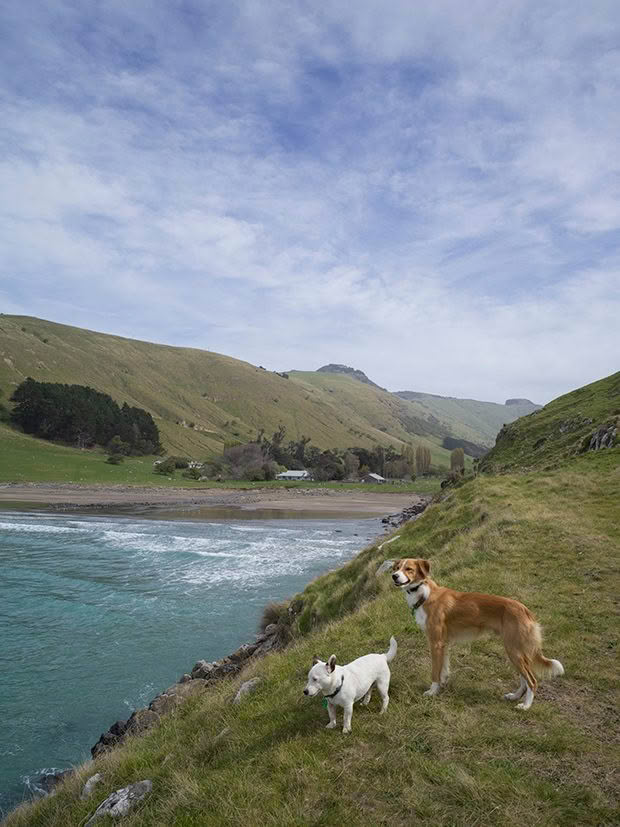
Crisis narrowly averted, the months — actually, years — of repair work to fences, tracks and buildings now underway are being taken in the family’s capable stride. That’s farming, Harriet says with a shrug. “If you’re going to live here, you need to be able to look after yourself. It’s not just about keeping the veggie garden watered and the cupboards stocked, it’s about self-reliance. Getting stuff done.”
And she’s used to it — because she grew up on this land like her father, his mother, and many others before them. The eldest of three girls — “and the bossiest”, Lloyd says, with a wink — Harriet never imagined she’d be living on the beach she was raised on. “As a younger woman, the idea of being a farmer’s wife just made me shudder,” she says. But there is a responsibility that comes with family land, one she says she feels “hugely”. And when she met Lloyd, a tall drink of water studying commerce and agriculture at Lincoln University, where Harriet was completing a degree in resource management, they just clicked.
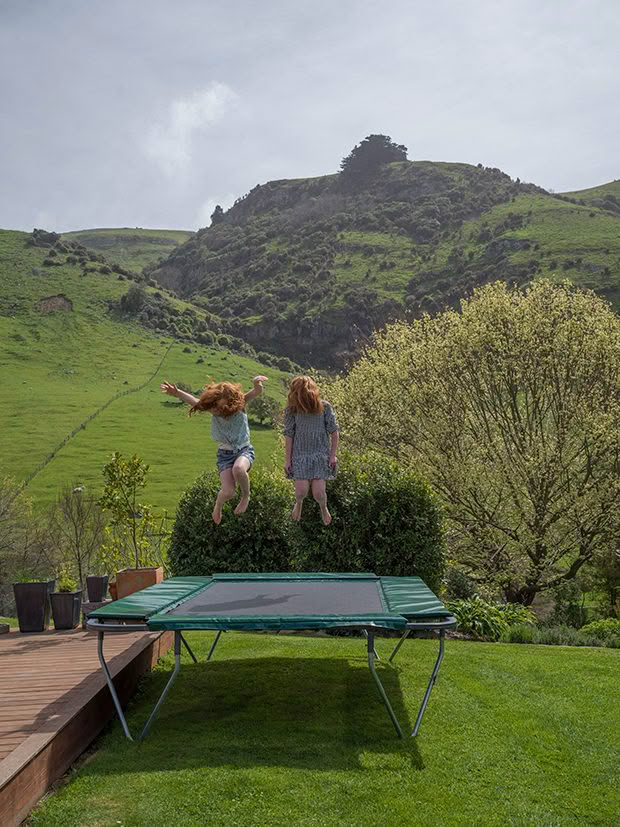
She drove him out to meet her family at Lavericks Bay for that 21st birthday in the woolshed. “I looked down from the crest of the hill and thought, ‘Well, I never want to farm here — it’s far too steep!’” recalls Lloyd.
However, when it came time for Harriet’s parents, Paul and Frances de Latour, to retire from Lavericks life, Harriet and Lloyd — who married on the property in 2006 — signed an initial three-year lease, all the while making plans to move on as soon as the agreement was up. “I knew how to farm, just not how to farm at Lavericks,” admits Lloyd. “We were pretty naïve. But we decided to give it a crack, and I loved it. A few years later, when we had the option to buy through Harriet’s family succession plan, it was too good an opportunity to pass up.”
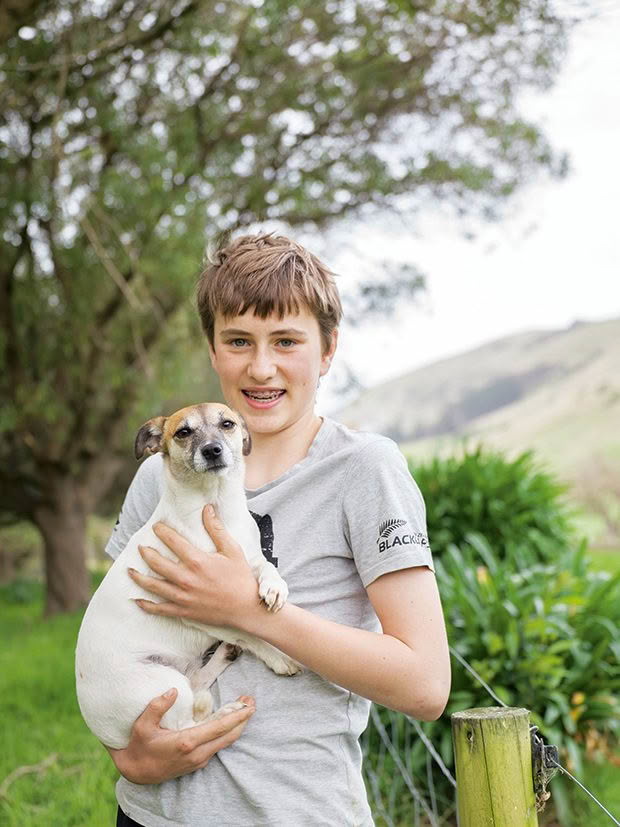
Joe (holding Dash, the jack russell) follows cricket, plays the drums and loves anything to do with motorbikes.
Lloyd confides that Lavericks has seeped into his blood, and he’s become so attached to this special place he could easily spend 365 days a year here. “Particularly because we don’t have mobile coverage. It means the kids talk to us. Or we ride motorbikes or play games.”
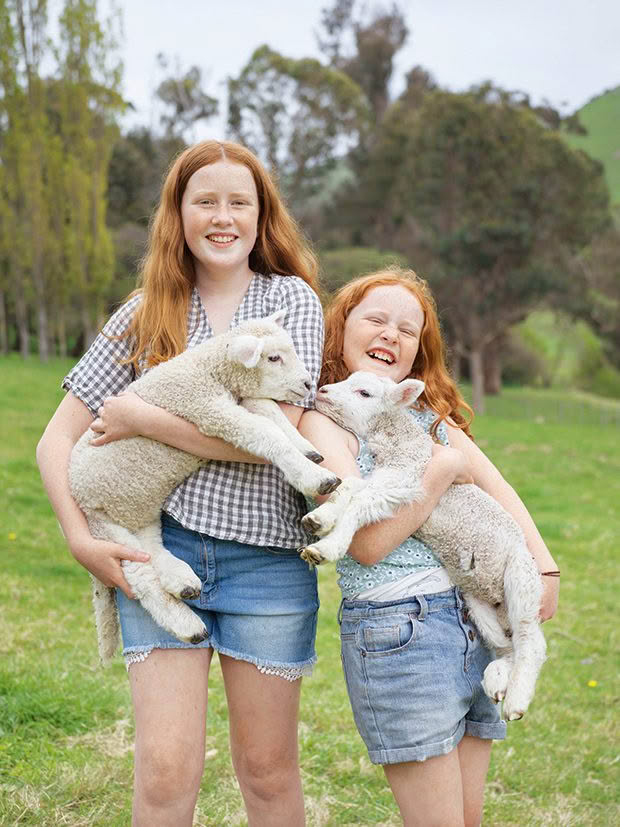
Scarlett (left) is a huge reader, and sister Willa is a little performer who loves hockey. “They’re allowed one activity per week — being so far away from Christchurch, we can’t manage more than that,” says Harriet.
Joe (14), Scarlett (12) and Willa (10) have pet lambs — Lady BaaBaa and Justin Bee-Baa are their latest recruits, although avid animal-lover Willa struggles terribly with the “plate” aspect of farm-to-plate, confides Harriet.
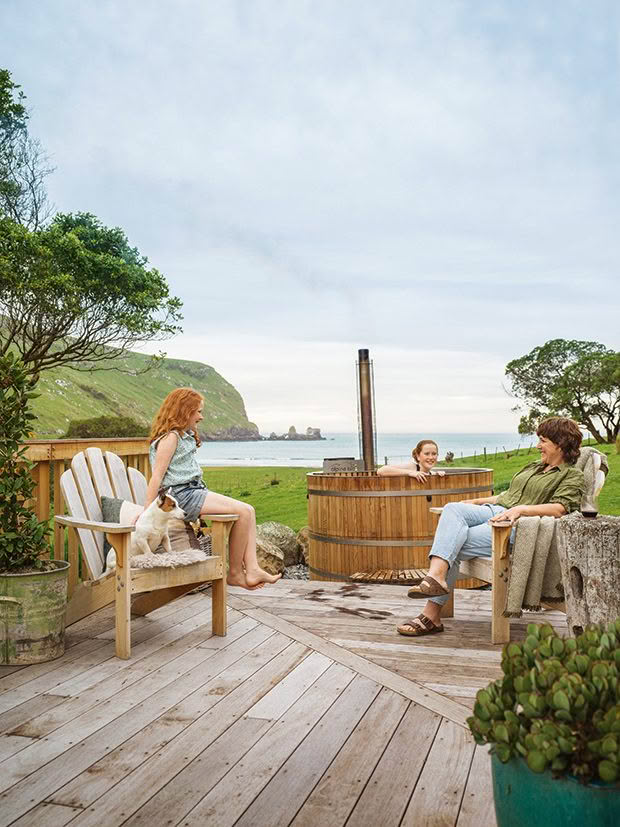
A soak in the woodfired hot tub is a highlight of any stay at Lavericks Bay Beach Cabin, the newest of the Chapmans’ two glamping operations. Harriet recommends loading the cavity with logs at bedtime and setting the alarm for before dawn. “As we are east-facing, the sunrises are wicked,” she says. “There’s nothing like being in the tub with a cup of tea as day breaks.” (Dash prefers to observe.)
But it’s not all roses, and this pair is the first to admit it. “A golden noose” is one way the cut-to-the-chase Chapmans describe it. At the same time, they’re delighted they’ve been able to give the kids an upbringing that mirrors Harriet’s own. “Living at the beach was just normal growing up,” she recalls, gazing across the belt of grass where sheep graze, to the sand beyond. “We’d swim, snorkel, take out the dinghy and put the nets down to catch butterfish and moki, ride our ponies, help on the farm, and drive over to Akaroa once a week to get groceries.”
Harriet had also observed how her mother opened the shearers’ quarters to families looking for a farm holiday far from the hustle and bustle of city life. As the newest caretaker of Lavericks and inspired by an article she read about the advent of glamping, she and Lloyd resolved to add it to the mix. Lavericks Bay Camp (two canvas safari tents sleeping seven, a hot tub, outdoor bath, and communal dining area) was established eight years ago, and the Lavericks Bay Beach Cabin is Harriet’s latest venture. It’s a renovated workers’ cottage with the most extraordinary views straight out to sea.
- Harriet and Lloyd take unplugging seriously — there are games, magazines and cosy spaces to enjoy throughout the Lavericks Bay Camp, an outdoor bath, and a woodburner in each tent.
- Harriet’s hand-crafted soap, made from clay, lanolin, lavender seeds, honey and essential oils, is a beautiful feature of the bathrooms.
- Guests wake to birdsong or the sound of Lloyd and his small team of farm workers whistling up the dogs.
The two together provide a revenue stream that helps shield the Chapmans from the highs and lows of their farming income. Wool prices have been particularly volatile, but climate-conscious Harriet senses change in the wind. “I firmly believe wool is one of the solutions to the environmental situation the world finds itself in,” she says. “There’s some incredible innovation in wool. It’s a wonder fibre, and I can’t wait for the rest of the world to catch up with it.”
The wool grown in Aotearoa is exported to Britain as part of Banks Peninsula Wool Growers, the cooperative Harriet’s father helped establish in 2007. His philosophy, and his son-in-law’s, is “to grow the best wool possible”, Lloyd says.
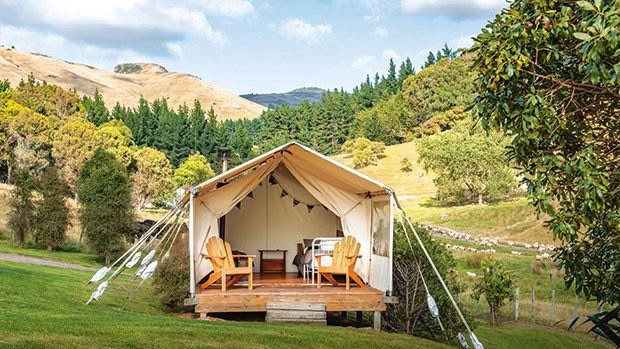
The sun has suddenly dropped away, and a fresh breeze has become icy. It’s time to hunt out slippers and pull on a jersey because the nights are cold at Lavericks.
The Chapmans are wedded to this spectacular land — rain or shine, drought or flood. “On a good day,” says Lloyd, as he bends to lace up boots, ready to finish another day on the farm, “there’s nowhere you’d rather be. And on a bad day, it’s still pretty good.”
THE PULL OF THE LAND
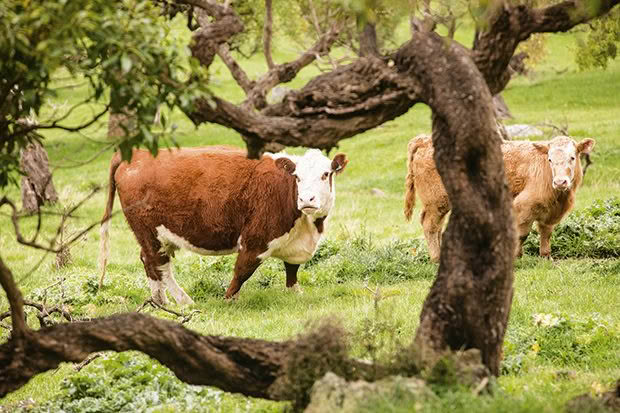
Lavericks Bay is a world away from — well — the world. Harriet and Lloyd run 6500 sheep and around 650 cattle on their 1000-hectare property, their end goal to leave the farm “in great condition” for the generation that follows, although none of their brood are showing any commitment at this early stage. “They are, however, fantastic pine cone collectors for our woodfired spas at the two glampsites,” says Harriet.
For now, Lloyd is commander in chief, and Harriet says he’s fallen in love with the remote, rugged terrain and the lifestyle. “He’s just so passionate about it. He works seven days a week,” the former town planner says, adding that she’s happy to take care of the home and the tourism operation. And there’s the childrens’ education to consider, too. The school at Le Bons Bay (current population 100) closed in 2012 with its roll dwindling to just four pupils, so Willa must make the daily trek to Akaroa Area School, leaving home just after 7am and not returning until after 4pm, while the older two board in Christchurch.
WOOLLY THINKING
Developing the second of her accommodation options, Lavericks Bay Cabin became an eco-project for Harriet. “I had a blank canvas and an ideal opportunity to be as sustainable as possible.” As proponents of the wool industry the Chapmans are very much a part of, it was a given that they would use wool in as many applications as are available, including wool batts to insulate the cabin walls, Dreamwool beds crafted from wool and latex and topped with woollen blankets and throws — even the first-aid kit includes woollen bandages from New Zealand start-up WoolAid. Outdoors, a woodfired hot tub is a perfect spot to soak up the views and breathe in the salty air. There’s recycled woollen weed matting from Terra Lana in the garden, and plenty of sheep to gaze at and chat to if you’re so inclined. Harriet says the people she meets here generally are. “Everyone who is attracted to glamping and this style of holiday are genuinely decent, interesting and nice — people who appreciate the surrounds, the lifestyle and the raw beauty of this isolated spot.”
Love this story? Subscribe now!
 This article first appeared in NZ Life & Leisure Magazine.
This article first appeared in NZ Life & Leisure Magazine.
